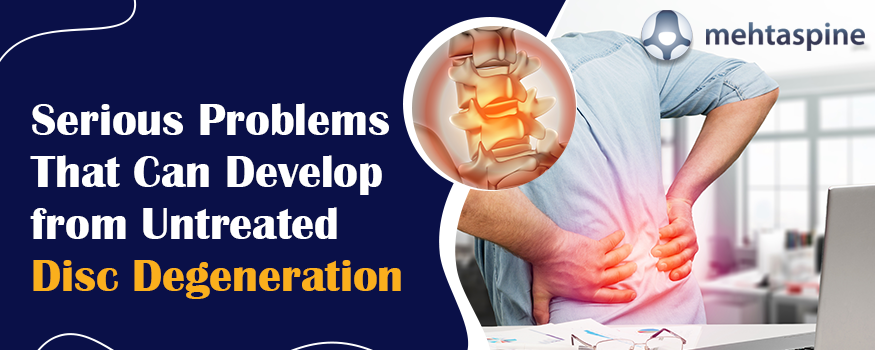5 Serious Spine Problems Caused by Untreated Disc Degeneration
The spinal discs serve as shock absorbers, providing support, stability, and flexibility to the spine while facilitating smooth movement between vertebrae. In some cases, these crucial spinal discs begin to deteriorate, causing a range of problems from chronic back pain to spinal nerve compression, limited mobility, muscle weakness, and even loss of sensation.
In most cases, spinal disc deterioration (technically, degeneration) is caused by wear and tear due to aging. “As we age, the spinal discs lose some of their fluid content and consequently lose flexibility and strength. This loss of vitality makes them more vulnerable to cracks, tears, bulges, which gradually deteriorate and cause disc degeneration that triggers many problems,” says Mr. Jwalant S. Mehta, a top orthopaedic surgeon for spine in the UK.
However, disc degeneration is not limited to old age:
Even younger individuals can suffer from spinal disc degeneration due to excessive stress or strain on the spine for long periods, genetics, and trauma injuries. Therefore, everyone must be aware of the potential risk of disc degeneration and improve their awareness about the problems it may cause when left untreated.
As part of our blog series, we want to discuss everything related to disc degeneration. With inputs from one of the best scoliosis surgeons in the UK, Mr. Jwalant S. Mehta, we will start by raising awareness of the severe spine problems that can happen if you don’t treat disc degeneration promptly.
Serious Spine Problems That Can Develop from Untreated Disc Degeneration:
- Herniated Disc:As the disc begins to deteriorate, it loses its water content, which makes it less flexible. The loss of flexibility increases the risk of cracks and tears on the outer wall, which causes the gel-like center to bulge. The bulge can press on the nearby spinal nerves, triggering pain, numbness, tingling sensations, and weakness in the areas controlled by that particular nerve.
- Spinal Stenosis:Degenerated discs can lose height, narrowing the spinal canal through which the spinal cord and nerves run. This spinal canal narrowing can compress the nerves, leading to weakness, difficulty walking, pain, and numbness similar to herniated discs.
- Spondylosis:The degeneration of spinal discs can also trigger the formation of bone spurs near the affected areas. These bone spurs further narrow the spinal canal, putting pressure on nerves, causing pain, and limiting mobility.
- Facet Joint Syndrome:As the spinal discs degenerate, they can also trigger the degeneration of facet joints, causing stress and strain. This chronic inflammation can lead to facet joint syndrome, which ultimately causes stiffness, inflammation, and pain in the affected joints. Facet joint syndrome is notorious for causing chronic back pain and limiting the range of motion.
- Spondylolisthesis:In severe cases of disc degeneration, the discs may move from their place and sometimes forward over one another. This displacement can lead to nerve compression that can also trigger pain, weakness, walking difficulty, mobility problems, and numbness.
Neither the above list is exhaustive, nor does disc degeneration immediately cause the spinal diseases mentioned. There are four stages of disc degeneration which include dysfunction, dehydration, stabilization, and collapse; it’s in the fourth stage where most of the above spinal diseases can occur.
So, how does one identify disc degeneration, what are the things to do to avoid disc degeneration, and what is the pain relief for disc degeneration disease? We often receive these follow-up questions, and we aim to provide detailed answers in our next blog. For immediate assistance with back pain due to disc problems, scoliosis, or any other unknown cause, please get in touch with adult and back pain specialist and orthopaedic spine surgeon Mr. Jwalant S. Mehta here.


